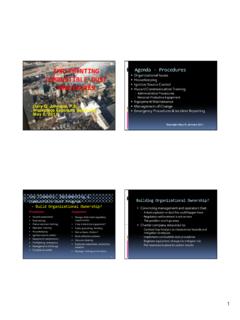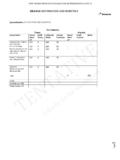Transcription of INTERNATIONAL FIRE TRAINING CENTRE
1 Issue 1 Jan 03. INTERNATIONAL fire TRAINING CENTRE . FIREFIGHTER INITIAL. fire EXTINGUISHING MEDIA DRY POWDER. Throughout this note he means he/she and his means his/hers. Areas of bold type are considered to be of prime importance. INTRODUCTION. This TRAINING note is intended to provide information to students attending the Firefighter Initial programme on the subject of Dry Powder extinguishing agents as relevant to Rescue and Firefighting Services (RFFS) employed at airports. This TRAINING note should be read in conjunction with other notes covering operational matters such as tactics and techniques, particularly in respect to dealing with incidents involving aircraft engines and undercarriage assemblies. AIM. The aim of this TRAINING note is to introduce students to Dry Powder and its use as an extinguishing agent. OBJECTIVES. At the end of the instructional session dealing with this subject and after detailed study of the TRAINING note you will be able to: Sate the properties of Dry Powder Describe the advantages and disadvantages Describe the methods of application State the areas of application Recognise the hazards GENERAL PROPERTIES.
2 As with most extinguishing agents, there are a number of different types of Dry Powder available. Some for use against specific risks, some that are more general purpose and some that have improved performance characteristics. The main types used by the Airport fire Service include: Sodium Bicarbonate Potassium Bicarbonate Mixed Powders (Monnex). D' Class Powders General Purpose Powders Issue 1 Jan 03. Sodium Bicarbonate This is the cheapest type of powder available. The powder itself consists of particles having irregular shapes, this results in a poor flow of powder under discharge conditions. Potassium Bicarbonate Owing to extra milling of this powder during processing, it has smaller particles and an enhanced flow capability compared to that of sodium bicarbonate. Mixed Powders A number of other products are available which are achieved by mixing various powders together, these include: Sodium and Potassium Sulphate Sodium and Barium Chloride Mon Ammonium Phosphate Di Ammonium Phosphate Some mixed powders have been given the name Monnex.
3 Monnex powders are widely used by the Airport fire Service because they are particularly effective on aviation fuel fires. D' Class Powders Some powders have been developed for use against Class D' (metal) fires such as Magnesium and Titanium. These powders contain an ingredient which melts, then flows a little and forms a crust over the burning metal, effectively sealing it from the surrounding atmosphere and isolating the fire . General Purpose Powders These are mixed powders that have been developed for use against Class A, B or C fires. PROPERTIES. Dry Powders, if exposed to the atmospheres, will absorb moisture from the air. This can lead to the powder caking and losing its ability to flow correctly. It is therefore, important to service extinguishers and store supplies of powder in clean, dry surroundings. As well as absorbing moisture, dry powder is capable of absorbing heat. A cloud of fine dry powder particles will offer some protection, to surrounding structures and the operator of the extinguisher, from the damaging effects of heat radiating from the fire .
4 It should be borne in mind that the cloud that is generated when powder is discharged will reduce the visibility of the operator and because it is made up of find powder particles, may cause breathing problems. EXTINGUISHING PROPERTIES. When dry powder is correctly applied to a fire it attacks and extinguishes it in two ways;. Firstly, by generating a fine powder cloud over the surface of the fire . This excludes the oxygen and so has a smothering effect on the fire . Secondly, dry powder works by interfering with the chemical reaction that causes fuel vapour to combine with oxygen. This in turn stops the combustion process. The combination of these two processes leads to very quick knockdown of flames. ADVANTAGES AND DISADVANTAGES. To help firefighters make informed judgements about the selection of the best extinguishing media for specific operational circumstances, an understanding of the advantages and disadvantages of each is essential. In respect of dry powder they are.
5 Issue 1 Jan 03. ADVANTAGES. Quick Knockdown Dry powder, when correctly applied and at the required application rate, has the ability to ensure an initial quick knockdown of the fire . Non Conductor of Electricity Dry powder can safely be used at incidents where it is known or suspected that live'. electrical equipment is present. Good on Running Fuel Fires Owing to its fire extinguishing action, dry powder, when used in conjunction with water/foam sprays, can be extremely effective when used on running fuel fires. Creates No Thermal Shock Because the application of dry powder onto hot metal does not cause thermal shock, it is particularly useful for dealing with fires involving undercarriage assemblies. Good Heat Shield The discharge of dry powder creates an effective shield against radiated heat. In cases where large quantities of powder are discharged, this has the potential to shield surrounding structures and personnel from the damaging effects of the fire . DISADVANTAGES.
6 Poor Post fire Security Due to the smothering and chemical interference effect of dry powder, it will only remain effective whilst it is present in the atmosphere above the fuel. Because it is a cloud of fine powder, particles of it can easily be dispersed by the wind, giving a very real danger of rapid re-ignition of fuel. Can Cause Breathing Problems If dry powder is inhaled it can irritate the respiratory organs. Whilst short term exposure is not considered to be harmful, repeated inhalation should be avoided. Visibility Problems The application of dry powder and generation of a dense powder cloud will dramatically reduce the visibility of the firefighter so they may not be able to use vision to judge the effectiveness of the powder on the fire . Leaves a Residue Dry powder is a very messy extinguishing agent that will leave behind a residue that is corrosive to certain materials and because it is a find powder it can also be abrasive. Thoughtless use may lead to the powder causing more damage than the fire itself.
7 Cloggs Valves Poor maintenance or maintenance in damp conditions, can lead to the powder caking. This in turn, can lead to the failure of equipment at a crucial time through clogged valves. Vulnerable to Packing Down Failure of equipment can also result from the packing down of the powder inside an extinguisher body. This is a particular problem for vehicle mounted equipment because the vehicle vibration will cause the powder to compress under its own weight. Again, sound, regular maintenance routines are essential to prevent failure of equipment at a crucial time. Issue 1 Jan 03. Can Break Down the Foam Blanket The use of dry powder close to an area covered by a foam blanket may lead to the foam breaking down more quickly. Where possible, this should be avoided, but if unavoidable, the foam blanket should be topped up. METHODS OF APPLICATION. The objective is to sweep the entire fire front from the upwind direction and to roll the fire back away from the firefighter.
8 This technique will ensure that the wind is used in resisting the tendency of the flame to turn back towards the firefighter. As an example, when dealing with a ground level fuel fire , the firefighter should get into a position upwind of the fire . Once in position, the dry powder applicator should be activated briefly to test the equipment. Once satisfied that the equipment is functioning satisfactorily, the firefighter should advance applying the powder towards the fire and at the same time in a sweeping motion from left to right. (see diagram below). Danger from Danger from flash back Advance flash back in this area! in this area! Wind direction Sweep from left to right advancing as you control the fire . As the advance continues, an aspirated foam blanket should be applied in order to back up the gains made by the powder, consolidate the advance and prevent the risk of the fire flashing back. As with all fires involving aviation fuels/aircraft, an aspirated foam blanket should be maintained throughout the incident for security.
9 DUAL APPLICATION. Extensive practical tests carried out by the UK CAA prove conclusively that dry powder can also be used to great effect in conjunction with the application of water/foam sprays in dealing with fires involving running fuel. In these situations greatest effect can be gained by initially containing the fire within a conical spray. This technique protects surrounding flammable material and personnel from radiated heat and provides a vehicle in which to take the dry powder into the very heart of the fire . Issue 1 Jan 03. In order to use this method of dual agent attack, simply encapsulate the fire within a conical spray of either water or water/foam solution and inject into the spray the dry powder applicator nozzle. In order to achieve the maximum effect it is necessary to inject the dry powder applicator nozzle into the conical spray itself, this will ensure that the powder is entrapped in the water and carried into the actual fire . Failure to inject the powder into the spray itself may result in much of the powder being caught up in the extremities of the spray and falling to waste outside the fire .
10 NOTE: When dealing with a running fuel fire , the application of media must start at low level and then work up towards the source of the fuel. APPLICATION AREAS. Dry powder has proved to be very effective in the following areas: Fuel spillage fires Running fuel fires Undercarriage fires Engine fires Fuel Spillage Fires Quick knockdown capability makes dry powder very effective when applied correctly to fuel spillage fires. Lack of Post fire Security means that it must be backed up with an aspirated foam blanket. Running Fuel Fires Where running fuel is ignited, quick intervention with dry powder either on its own or as part of a dual agent attack, can arrest the spread of fire . The application of media must begin at the lowest level and work upwards. Action must also be taken to stem the flow of fuel and cover pooled fuel with an aspirated foam blanket. Undercarriage Fires Because dry powder has very little cooling effect it can be effectively used to deal with undercarriage fires.



